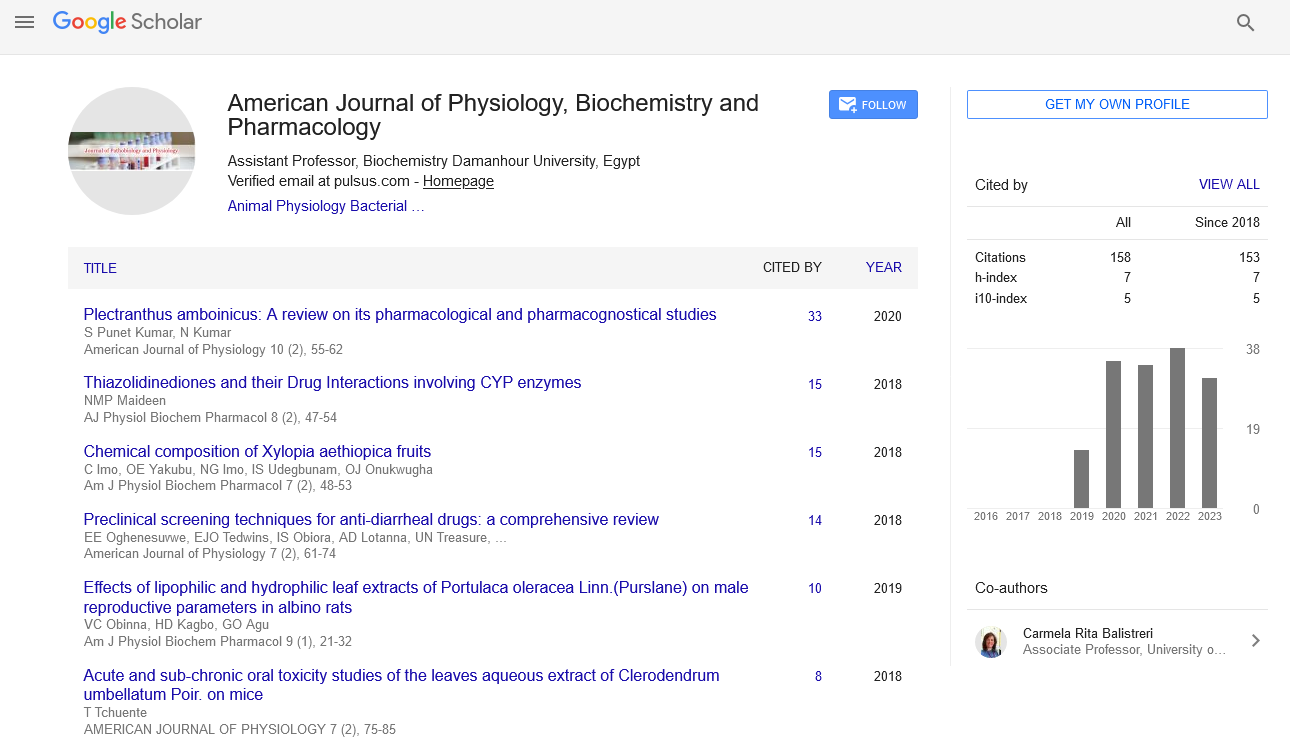Short Communication - American Journal of Physiology, Biochemistry and Pharmacology (2022)
Techniques and Procedures Involved to Study Anatomy
Lee Xin*Lee Xin, Department of Physiology, University of Waterloo, Waterloo, Canada, Email: leexin@gmail.com
Received: 03-Nov-2022, Manuscript No. AJPBP-22-81960; Editor assigned: 07-Nov-2022, Pre QC No. AJPBP-22-81960 (PQ); Reviewed: 21-Nov-2022, QC No. AJPBP-22-81960; Revised: 25-Nov-2022, Manuscript No. AJPBP-22-81960 (R); Published: 05-Dec-2022
Description
The study of the body’s systems, structures, and interactions is known as anatomy and physiology. Anatomy focuses on the physical configuration of the body’s components; physiology investigates how cells, tissues, and organs actually work. Whereas anatomy deals with the interior and external structures of the body and their physical interactions. Anatomy and physiology are defined along with their significance to biomedical engineering. The practise of medicine and other branches of health requires a solid understanding of anatomy. Since these are processes that produce anatomy on both short and long term timelines [1]. A common pairing of related disciplines is anatomy and physiology, which examine the structure and operation of organisms and their parts, respectively. Understanding physiological function and how both structure and function are affected by disease requires an understanding of the structure of the human body from what can be seen with the unassisted eye (gross anatomy) down to the molecular level. One of the fundamental basic disciplines are used in medicine is human anatomy. The study of human anatomy focuses on the human body’s structural makeup. Microscopic Anatomy and Macroscopic Anatomy are the two main types of Anatomy [2].
Microscopic Anatomy is a branch of anatomy known as microscopic anatomy (tiny) uses microscopes to look at the body’s tiniest components by including its tissues, cells, and molecules. The equipment available restricts the scope of microscopic anatomy study. Cytology is the study of cells that has been expanded to encompass both the molecules that make up the organelles, which are subcellular parts of cells. The molecular scale structures can only be seen with extremely strong electron microscopes [3]. The field of biology is known as histology that commonly referred to as microscopic anatomy or microanatomy, analyses the microscopic anatomy of biological tissues. The microscopic equivalent of gross anatomy, which examines larger structures that are visible without a microscope, is histology. The compound microscope can be used to examine a wide range of samples, including tissue, thin sections of organs, blood cells, cheek cells, parasites, bacteria, and algae. In order to observe samples that are invisible to the naked eye, compound microscopes are utilized.
As microscope technology developed, anatomists were able to see smaller and smaller details of the human body, from slices of larger organs like the heart to the three-dimensional configurations of huge molecules [4]. Examining relatively big structures and features that are often apparent to the unaided eye is known as macroscopically anatomy. The study of anatomy at the visible or macroscopic level is known as gross anatomy. Histology, which studies microscopic anatomy, is the opposite of gross anatomy. In order to better understand how different parts of an organism interact with one another and with other parts of the organism, gross anatomy studies the human body as well as the bodies of other species. Gross anatomy can be studied on dead creatures through dissection or on live ones through medical imaging. For the majority of health practitioners, training provides training in human gross anatomy [5]. The human body’s organ systems, the study of the body’s systems, structures, and interactions is known as anatomy and physiology [6].
Conclusion
Basic information about the human body is provided through anatomy and physiology. It aids in revealing key ideas regarding how our bodies work. We can learn about the practical functions of the human body in addition to the theoretical concepts taught in anatomy and physiology studies.
References
- Arráez-Aybar LA, Sánchez-Montesinos I, Mirapeix RM, Mompeo-Corredera B, Sañudo-Tejero JR. Relevance of human anatomy in daily clinical practice. Ann Anat. 2010; 192(6):341-8.
[Crossref] [Google Scholar] [Pubmed]
- Gribble N, Reynolds K. Use of angiography to outline the cardiovascular anatomy of the sand crab Portunus pelagicus Linnaeus. J Crustac Biol. 1993; 13(4):627-37.
- Benson KG, Forrest L. Characterization of the renal portal system of the common green iguana (Iguana iguana) by digital subtraction imaging. J Zoo Wildl Med. 1999; 30(2):235-41.
[Google Scholar] [Pubmed]
- Reinarz J. The age of museum medicine: The rise and fall of the medical museum at Birmingham's school of medicine. Soc Hist Med. 2005; 18(3):419-37.
[Crossref] [Google Scholar] [Pubmed]
- McLachlan JC, Patten D. Anatomy teaching: Ghosts of the past, present and future. Med Educ. 2006; 40(3):243-53.
[Crossref] [Google Scholar] [Pubmed]
- Von Staden H. The discovery of the body: Human dissection and its cultural contexts in ancient Greece. Yale J Biol Med. 1992; 65(3):223.
[Google Scholar] [Pubmed]
Copyright: © 2022 The Authors. This is an open access article under the terms of the Creative Commons Attribution NonCommercial ShareAlike 4.0 (https://creativecommons.org/licenses/by-nc-sa/4.0/). This is an open access article distributed under the terms of the Creative Commons Attribution License, which permits unrestricted use, distribution, and reproduction in any medium, provided the original work is properly cited.






